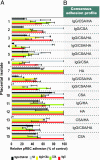Nonimmune immunoglobulin binding and multiple adhesion characterize Plasmodium falciparum-infected erythrocytes of placental origin
- PMID: 16945914
- PMCID: PMC1564255
- DOI: 10.1073/pnas.0601519103
Nonimmune immunoglobulin binding and multiple adhesion characterize Plasmodium falciparum-infected erythrocytes of placental origin
Abstract
The harmful effects of pregnancy-associated malaria (PAM) are engendered by the heavy sequestration of Plasmodium falciparum-parasitized RBCs in the placenta. It is well documented that this process is mediated by interactions of parasite-encoded variant surface antigens and placental receptors. A P. falciparum erythrocyte membrane protein 1 variant, VAR2CSA, and the placental receptor chondroitin sulfate A (CSA) are currently the focus of PAM research. A role for immunoglobulins (IgG and IgM) from normal human serum and hyaluronic acid as additional receptors in placental sequestration have also been suggested. We show here (i) that CSA and nonimmune IgG/IgM binding are linked phenotypes of in vitro-adapted parasites, (ii) that a VAR2CSA variant shown to bind CSA also harbors IgG- and IgM-binding domains (DBL2-X, DBL5-epsilon, and DBL6-epsilon), and (iii) that IgG and IgM binding and adhesion to multiple receptors (IgG/IgM/HA/CSA) rather than the exclusive binding to CSA is a characteristic of fresh Ugandan placental isolates. These findings are of importance for the understanding of the pathogenesis of placental malaria and have implications for the ongoing efforts to develop a global PAM vaccine.
Conflict of interest statement
Conflict of interest statement: No conflicts declared.
Figures




References
-
- Steketee RW, Nahlen BL, Parise ME, Menendez C. Am J Trop Med Hyg. 2001;64:28–35. - PubMed
-
- Rasti N, Wahlgren M, Chen Q. FEMS Immunol Med Microbiol. 2004;41:9–26. - PubMed
-
- Shulman CE, Marshall T, Dorman EK, Bulmer JN, Cutts F, Peshu N, Marsh K. Trop Med Int Health. 2001;6:770–778. - PubMed
-
- Fried M, Duffy PE. Science. 1996;272:1502–1504. - PubMed
Publication types
MeSH terms
Substances
LinkOut - more resources
Full Text Sources
Research Materials
Miscellaneous

